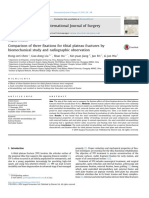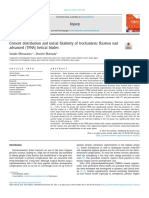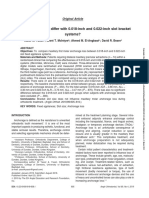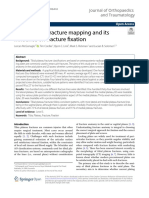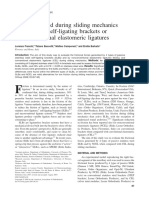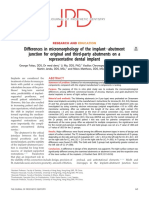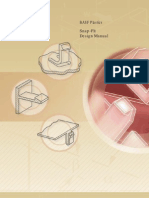0 ratings0% found this document useful (0 votes)
26 viewsBiomechanical Evaluation of The Surgical Implant Generation Network (SIGN) Intramedullary Tibial Nail
Biomechanical Evaluation of The Surgical Implant Generation Network (SIGN) Intramedullary Tibial Nail
Uploaded by
Tefera LeteboThis study biomechanically evaluated the Surgical Implant Generation Network (SIGN) intramedullary tibial nail. Mechanical testing found no significant difference in torsional stiffness between the SIGN nail and a Russel-Taylor nail, but the SIGN nail showed significantly more stiffness under axial loading and greater plastic deformation under cyclic loading.
Copyright:
© All Rights Reserved
Available Formats
Download as PDF, TXT or read online from Scribd
Biomechanical Evaluation of The Surgical Implant Generation Network (SIGN) Intramedullary Tibial Nail
Biomechanical Evaluation of The Surgical Implant Generation Network (SIGN) Intramedullary Tibial Nail
Uploaded by
Tefera Letebo0 ratings0% found this document useful (0 votes)
26 views1 pageThis study biomechanically evaluated the Surgical Implant Generation Network (SIGN) intramedullary tibial nail. Mechanical testing found no significant difference in torsional stiffness between the SIGN nail and a Russel-Taylor nail, but the SIGN nail showed significantly more stiffness under axial loading and greater plastic deformation under cyclic loading.
Original Description:
a
Original Title
0838
Copyright
© © All Rights Reserved
Available Formats
PDF, TXT or read online from Scribd
Share this document
Did you find this document useful?
Is this content inappropriate?
This study biomechanically evaluated the Surgical Implant Generation Network (SIGN) intramedullary tibial nail. Mechanical testing found no significant difference in torsional stiffness between the SIGN nail and a Russel-Taylor nail, but the SIGN nail showed significantly more stiffness under axial loading and greater plastic deformation under cyclic loading.
Copyright:
© All Rights Reserved
Available Formats
Download as PDF, TXT or read online from Scribd
Download as pdf or txt
0 ratings0% found this document useful (0 votes)
26 views1 pageBiomechanical Evaluation of The Surgical Implant Generation Network (SIGN) Intramedullary Tibial Nail
Biomechanical Evaluation of The Surgical Implant Generation Network (SIGN) Intramedullary Tibial Nail
Uploaded by
Tefera LeteboThis study biomechanically evaluated the Surgical Implant Generation Network (SIGN) intramedullary tibial nail. Mechanical testing found no significant difference in torsional stiffness between the SIGN nail and a Russel-Taylor nail, but the SIGN nail showed significantly more stiffness under axial loading and greater plastic deformation under cyclic loading.
Copyright:
© All Rights Reserved
Available Formats
Download as PDF, TXT or read online from Scribd
Download as pdf or txt
You are on page 1of 1
Biomechanical Evaluation of the Surgical Implant Generation Network (SIGN) Intramedullary Tibial Nail
+1Antkowiak, T; 1Khalafi, A; 1Neu, C; 1Moehring, D
+1University of California Davis, Sacramento, CA
Senior author: moehring.david@ucdmc.ucdavis.edu
INTRODUCTION: statistically significant differences in axial and torsional stiffness and
The orthopaedic community has become increasingly plastic deformation between each group. The level of significance was
cognizant of the disparity that exists in healthcare throughout the defined as PB 0.05.
developing world(1). Annually, there are nearly five million deaths
worldwide due to traumatic injuries; a number approximating that of RESULTS:
HIV/AIDS, malaria and tuberculosis combined(2). Motor vehicle trauma Mechanical testing was successfully performed on 10 SIGN
accounts for a large proportion of these deaths, and for every death there nail models and on 10 Russel-Taylor (RT) constructs. All tests were run
are many more left permanently disabled. In developing nations, to completion and no catastrophic hardware failures occurred.
significant rural-to-urban population shifts and industrialization are The torsional stiffness test revealed no statistically significant
causing significant increases in the number of industrial and motor difference between the SIGN nail and the RT nail. The mean torsional
vehicle accidents. These trends are expected not only to continue but to stiffness of the SIGN nail was 1.125 ± 0.057 Nm/degree, while mean
accelerate substantially. torsional stiffness for the RT nail was 1.242 ± 0.079 Nm/degree
Of all long bone fractures sustained during accidents tibial (p=0.221).
fractures are the most common(3). In developing countries the optimum Under axial loading the SIGN nail showed significantly more
treatment method for complex fractures of the tibia remains stiffness than the RT nail. The mean axial stiffness for the SIGN
controversial. Options for stabilization include cast immobilization, construct was 1897.29 ± 103.98 N/mm, whereas the mean axial stiffness
external fixation, open reduction and plate fixation, and intramedullary for the RT construct was 1290.78 ± 90.43 N/mm (p=0.001).
(IM) nailing. IM devices have become the most popular implant choice Cyclic loading protocols revealed that plastic deformity was
in developed nations(3). However, the significant costs and the equipment significantly greater in the SIGN nail than in the RT nail. Plastic
needed to place these devices have made their use challenging in the deformity was -1.627 ± 0.31mm for the SIGN construct and -0.633 ±
developing world. 0.056mm for the RT construct (p=0.006). However, total deformity for
In 1999, the Surgical Implant Generation Network (SIGN) of the two nails was not significantly different. Total deformity for the
Richland, Washington, was created as a non-profit humanitarian SIGN nail was -3.14 ± 0.322mm and for the RT nail it was 2.577 ±
organization aiming to provide quality orthopaedic equipment and care 0.094mm (p=0.108).
at little or no cost to developing nations in need. To date, more than
36,000 patients have been treated with the SIGN IM femoral or tibial DISCUSSION:
nail(2). The SIGN tibial system is a solid IM nail with interlocking In the developed world, IM fixation has become somewhat of
capability. Proximal and distal cross-locks are placed using a mechanical a gold standard for treatment of both open and closed fractures of the
aiming device thereby eliminating the need for costly, cumbersome and tibial shaft. A recent study by Bhandari et al. surveyed more than 400
largely unavailable C-arm systems. North American and international orthopaedic surgeons. They found that
A recent series published by Shah et al demonstrated a 90% over 95% preferred to use IMN for treatment of both high energy and
union rate in open tibial fractures treated with the SIGN system(4). To low energy tibial shaft fractures(3).
our knowledge, no previous study has evaluated the mechanical The SIGN nail provides the developing world with access to
properties of the SIGN tibial nail system. The purpose of this study was, IM technology at little or no cost. The efficacy of this construct in vivo
therefore, to elucidate the mechanical properties of this solid nail and has already been confirmed(4). Our study further elucidates the exact
compare them with those of a commonly used North American hollow mechanical properties of this solid nail. In direct comparison to a
construct. standard hollow nail we have shown that the SIGN nail is stiffer under
axial loading. This result is not surprising given the solid nature of this
MATERIALS AND METHODS: device. However, this axial stiffness does not appear to correlate with
A fracture gap model, 3cm wide and 18.5 cm proximal to the deformation under cyclical loading. Despite its solid nature, the SIGN
plafond, was created using tibial synthetic composite bones to simulate a nail exhibits significantly more plastic deformity than its hollow
comminuted mid-shaft tibia fracture (AO/OTA42-A3). Un-reamed counterpart. Interestingly, total deformity for the two nails was not
fracture fixation was achieved using either a 9mm x 340mm solid SIGN significantly different and neither construct experienced any catastrophic
661 tibial nail or a 10 mm x 34.5 mm Russel-Taylor tibial nail with two failures.
proximal and distal interlocks, respectively. Mechanical testing was Although some statistically significant differences exist
performed using a materials testing machine (Instron 5800 R, Canton, between the SIGN nail and the RT nail, the SIGN construct appears to
MA) with main outcome measures being stiffness in axial and torsional have the biomechanical potential for strength and longevity. As
loading, as well as total and irreversible (plastic) deformation in cyclical developing economies grow and expand, the incidence of traumatic
axial loading. Testing was stopped after either a visual loss of fixation or injuries will continue to rise. The availability and efficacy of the SIGN
a sudden change in construct stiffness, as reflected by the load- nail will allow surgeons in the developing world to provide gold
displacement curve. standard care to their trauma patients.
For torsional loading tests the constructs were preloaded to 5
Nm and then torqued to a maximum of 20 Nm at a rate of 20 REFERENCES:
degrees/min. Axial loading was assessed by loading the construct in 1. Dormans, J., Orthopaedic Surgery In The Developing World – Can
compression at a loading rate of 100 N/s. After stabilizing the construct Orthopaedic Residents Help? Journal of Bone and Joint Surgery. 2002;
with a preload of 100 N, axial loading was performed to a maximum 84A(6):1086-1094.
load of 500 N. Cyclical axial loading consisted of 10 incremental cycles 2. Zirkle, L Jr., Injuries in Developing Countries – How Can We Help?:
starting with 500 N. The load for each successive increment was The role of Orthopaedic Surgeons. Clinical Orthopaedics and Related
increased by 500 N, to a maximum load of 2500 N, with 10 seconds of Research. 2008; DOI 10.1007/s11999-008-0387-0.
rest between each increment. The preload and baseline load after each 3. Bhandari M, Guyatt G, Tornetta P 3rd, Swiontkowski M, Hanson B,
cycle was 100 N. Testing was conducted at a loading rate of 100 N/s. Sprague S, Syed A, Schemitsch E., Current Practice in the
For axial and torsional testing, a load-displacement curve was Intramedullary Nailing of Tibial Shaft Fractures: An International
plotted for each construct and the stiffness was calculated as the slope of Survey. The Journal of Trauma. 2002; 53(4):725-732.
the initial region of the curve. Plastic deformation was calculated by 4. Shah R, Moehring D, Singh R, Dhakal A., Surgical Implant
subtracting the amount of displacement present at the start of the first Generation Network (SIGN) Intramedullary Nailing of Open Fracture of
cyclical axial cycle (500 N) from displacement present after the final the Tibia. International Orthopaedics. 2004; 28:163-166.
cycle. Total deformation was recorded after the last testing cycle. A one-
way analysis of variance (ANOVA) was performed to determine
Poster No. 838 • 55th Annual Meeting of the Orthopaedic Research Society
You might also like
- J. D. Todd (Auth.) - Structural Theory and Analysis-Macmillan Education UK (1981) PDFDocument388 pagesJ. D. Todd (Auth.) - Structural Theory and Analysis-Macmillan Education UK (1981) PDFJesus Ortiz100% (2)
- Comparison Between Different Commercial Gear Tooth Contact Analysis Software PackagesDocument16 pagesComparison Between Different Commercial Gear Tooth Contact Analysis Software PackagesAbhijeet DeshmukhNo ratings yet
- Lab Manual For Theory of Structure IIDocument11 pagesLab Manual For Theory of Structure IIUral Prakash KafleNo ratings yet
- Influência Do Tipo de Rosca No Torque de Remoção Dos Mini-Implantes - HongDocument8 pagesInfluência Do Tipo de Rosca No Torque de Remoção Dos Mini-Implantes - HongUrsula Pantigozo MoránNo ratings yet
- Pi Is 0889540607001448Document1 pagePi Is 0889540607001448djosephjohn89No ratings yet
- Schneider 2001Document9 pagesSchneider 2001gbgzeraNo ratings yet
- Effects of Third-Order Torque On Frictional Force of Self-Ligating BracketsDocument8 pagesEffects of Third-Order Torque On Frictional Force of Self-Ligating Bracketsmanuela castroNo ratings yet
- Na Orces Between Bracket and Are: Bonn, West GermanyDocument8 pagesNa Orces Between Bracket and Are: Bonn, West GermanyGoutam NookalaNo ratings yet
- Tsumita 2013Document5 pagesTsumita 2013JesusCordobaNo ratings yet
- In Vitro Study of Frictional Forces During Sliding Mechanics of "Reduced-Friction" BracketsDocument5 pagesIn Vitro Study of Frictional Forces During Sliding Mechanics of "Reduced-Friction" BracketsLAURA ESNEDA GIRALDO MEJIANo ratings yet
- Bone Stress When Miniplates Are Used For OrthodontDocument7 pagesBone Stress When Miniplates Are Used For OrthodontNicolasFernandezNo ratings yet
- Mechanical Properties of NiTi and CuNiTi Shape-Memory Wires Used in Orthodontic Treatment. Part 1: Stress-Strain TestsDocument9 pagesMechanical Properties of NiTi and CuNiTi Shape-Memory Wires Used in Orthodontic Treatment. Part 1: Stress-Strain TestsClaudiaNo ratings yet
- Nihms 1954Document14 pagesNihms 1954mateo bravoNo ratings yet
- Self Ligation BracketsDocument8 pagesSelf Ligation BracketsSreenivasa Krishna ChaitanyaNo ratings yet
- Bun PIIS174391911400973XDocument5 pagesBun PIIS174391911400973XNorin FornaNo ratings yet
- Cement Distribution and Initial Fixability of Trochanteric Fixation 2022 InjDocument6 pagesCement Distribution and Initial Fixability of Trochanteric Fixation 2022 InjBM MANo ratings yet
- Does Anchorage Loss Differ With 0.018-Inch and 0.022-Inch Slot Bracket Systems?Document6 pagesDoes Anchorage Loss Differ With 0.018-Inch and 0.022-Inch Slot Bracket Systems?jcesar8745No ratings yet
- Finite Element Analysis of Miniscrew Implants Used For Orthodontic AnchorageDocument9 pagesFinite Element Analysis of Miniscrew Implants Used For Orthodontic Anchoragemanju deviNo ratings yet
- CJV 017Document9 pagesCJV 017malifaragNo ratings yet
- Art 1Document11 pagesArt 1Jenny Vargas RuizNo ratings yet
- 23 PDFDocument7 pages23 PDFPae Anusorn AmtanonNo ratings yet
- MBT..Does Anchorage Loss Differ With 0.018-Inch and 0.022-Inch Slot Bracket SYSTEMS PDFDocument6 pagesMBT..Does Anchorage Loss Differ With 0.018-Inch and 0.022-Inch Slot Bracket SYSTEMS PDFcatherineNo ratings yet
- MBT..Does Anchorage Loss Differ With 0.018-Inch and 0.022-Inch Slot Bracket SYSTEMS PDFDocument6 pagesMBT..Does Anchorage Loss Differ With 0.018-Inch and 0.022-Inch Slot Bracket SYSTEMS PDFcatherineNo ratings yet
- Comparison of Shear Bond Strength of Occlusal Pad Debonding Pliers Before and After Eryag Laser Application An in VitroDocument6 pagesComparison of Shear Bond Strength of Occlusal Pad Debonding Pliers Before and After Eryag Laser Application An in VitroAnonymous 064ILkNo ratings yet
- Article 014Document12 pagesArticle 014MedstudNo ratings yet
- Nailing Intertrochanteric Hip Fractures Short Versus Long Locked Versus NonlockedDocument7 pagesNailing Intertrochanteric Hip Fractures Short Versus Long Locked Versus NonlockedpablopabloortizortizNo ratings yet
- 2021 In-Vitro Fatigue Performance Connection PRAMADocument7 pages2021 In-Vitro Fatigue Performance Connection PRAMASahasraNo ratings yet
- McGonagle2019 Article TibiaPlateauFractureMappingAndDocument6 pagesMcGonagle2019 Article TibiaPlateauFractureMappingAndFarizka Dwinda HNo ratings yet
- Friction Between Various Self-Ligating Brackets and Archwire Couples During Sliding MechanicsDocument5 pagesFriction Between Various Self-Ligating Brackets and Archwire Couples During Sliding MechanicsNievecillaNeiraNo ratings yet
- Biomechanical evaluation of maxillary Lefort Ι fracture with bioabsorbable osteosynthesis internal fixationDocument9 pagesBiomechanical evaluation of maxillary Lefort Ι fracture with bioabsorbable osteosynthesis internal fixationSuci NourmalizaNo ratings yet
- Tecnica Segmentaria Vs DeslizamientoDocument6 pagesTecnica Segmentaria Vs Deslizamientoortodoncia 2018No ratings yet
- Occlusal Interferences and Cantilever Joint Stress in Implant-Supported Prostheses Occluding With Complete Dentures.Document13 pagesOcclusal Interferences and Cantilever Joint Stress in Implant-Supported Prostheses Occluding With Complete Dentures.Teresa BeltranNo ratings yet
- Art:10.1007/s11999 010 1557 4Document8 pagesArt:10.1007/s11999 010 1557 4benife8420No ratings yet
- Ferrule Effect DiscussionDocument4 pagesFerrule Effect DiscussionBinu P NairNo ratings yet
- 1 PBDocument14 pages1 PBrb26dettNo ratings yet
- (2008 Weng) Influence of Microgap Location and Configuration On The Periimplant Bone Morphology in Submerged Implants. An Experimental Study in DogsDocument7 pages(2008 Weng) Influence of Microgap Location and Configuration On The Periimplant Bone Morphology in Submerged Implants. An Experimental Study in Dogsyena1010No ratings yet
- Of Of: Evaluation Strain Terminal Abutmentsite Fixed Mandibular Prosthesis During Cantilever LoadingDocument10 pagesOf Of: Evaluation Strain Terminal Abutmentsite Fixed Mandibular Prosthesis During Cantilever Loadingjinny1_0No ratings yet
- Accepted: Can We Stop Measuring For These Screws?Document12 pagesAccepted: Can We Stop Measuring For These Screws?Edson Salinas AlvarezNo ratings yet
- Comparison of CADCAM Abutment and Prefabricated AbDocument8 pagesComparison of CADCAM Abutment and Prefabricated AbLudwin VanNo ratings yet
- The Technique of S2-Alar-Iliac Screw Fixation: A Literature ReviewDocument8 pagesThe Technique of S2-Alar-Iliac Screw Fixation: A Literature Reviewdps_1976No ratings yet
- Dissertation On Finite Element Analysis in OrthodonticsDocument7 pagesDissertation On Finite Element Analysis in OrthodonticsPaperHelpWritingCanadaNo ratings yet
- Proximal Femoral Nailing ArticleDocument10 pagesProximal Femoral Nailing ArticlePirthi MannNo ratings yet
- Forces Released During Sliding Mechanics With Passive Self-Ligating Brackets or Nonconventional Elastomeric LigaturesDocument4 pagesForces Released During Sliding Mechanics With Passive Self-Ligating Brackets or Nonconventional Elastomeric LigaturesRafaella MedinaNo ratings yet
- Bond Strength of Dental Bracket The Finite Element Method: A Tool To Evaluate ShearDocument7 pagesBond Strength of Dental Bracket The Finite Element Method: A Tool To Evaluate ShearSundaraPandiyanNo ratings yet
- Comparison of Torsional Stability of 2 Types of Split Crimpable Surgical Hooks With Soldered Brass Surgical HooksDocument5 pagesComparison of Torsional Stability of 2 Types of Split Crimpable Surgical Hooks With Soldered Brass Surgical HooksГне ДзжNo ratings yet
- Kortam Sahira IbrahimDocument77 pagesKortam Sahira Ibrahimjuanita_luna_7No ratings yet
- Application of Three-Dimensional Printing Technology in The Orbital Blowout Fracture ReconstructionDocument4 pagesApplication of Three-Dimensional Printing Technology in The Orbital Blowout Fracture Reconstructionstoia_sebiNo ratings yet
- Mechanical Complications of Dental Implants: RationaleDocument3 pagesMechanical Complications of Dental Implants: RationaleGerman Orozco OrtizNo ratings yet
- Platform SwitchingDocument7 pagesPlatform SwitchingFernando CursachNo ratings yet
- Injury: Gyeong Min Kim, Kwang Woo Nam, Kyu-Bum Seo, Chaemoon Lim, Jiyun Kim, Yong-Geun ParkDocument8 pagesInjury: Gyeong Min Kim, Kwang Woo Nam, Kyu-Bum Seo, Chaemoon Lim, Jiyun Kim, Yong-Geun ParkHans MartinNo ratings yet
- Lucilia Zimmermann, 2014Document9 pagesLucilia Zimmermann, 2014krosodontologoNo ratings yet
- In Vivo Evaluation of Ankle Kinematics and TibiotaDocument11 pagesIn Vivo Evaluation of Ankle Kinematics and TibiotaMauricio MoncadaNo ratings yet
- Stabilization of Distal Humerus Fractures by Precontoured Bi-Condylar Plating in A 90-90 PatternDocument5 pagesStabilization of Distal Humerus Fractures by Precontoured Bi-Condylar Plating in A 90-90 PatternmayNo ratings yet
- PIIS0022391318301926Document8 pagesPIIS0022391318301926priyaNo ratings yet
- Influência Das Forças Rotacionais Na Estabilidade Do Mini-Implante - ChoDocument6 pagesInfluência Das Forças Rotacionais Na Estabilidade Do Mini-Implante - ChoUrsula Pantigozo MoránNo ratings yet
- Evaluation of Mechanical Performance of Orthodontic Mini-Implants With Distinct DesignsDocument6 pagesEvaluation of Mechanical Performance of Orthodontic Mini-Implants With Distinct DesignsRebin AliNo ratings yet
- A Cadaveric Comparison of Two Methods For Isolated TalonavicularDocument7 pagesA Cadaveric Comparison of Two Methods For Isolated TalonavicularDiego Rivas-VazquezNo ratings yet
- Effectof Clinical Useonthe Cyclic Fatigue Resistanceof Pro Taper NickelDocument5 pagesEffectof Clinical Useonthe Cyclic Fatigue Resistanceof Pro Taper NickelliaamNo ratings yet
- Aatika 9Document11 pagesAatika 9Abhishek GuptaNo ratings yet
- Implant Stability - Measuring DevicesDocument19 pagesImplant Stability - Measuring DevicesÁgnes Kocsis100% (1)
- 2015 - Biomechanical Evaluation of Different Angle-Stable Locking Plating Systems For Mandibular SurgeryDocument30 pages2015 - Biomechanical Evaluation of Different Angle-Stable Locking Plating Systems For Mandibular SurgeryLeandro Nascimento Rodrigues dos santosNo ratings yet
- Mecanica de OclusionDocument8 pagesMecanica de OclusionMonica GuevaraNo ratings yet
- Flexor Tendon Injuries: PrefaceDocument2 pagesFlexor Tendon Injuries: PrefaceTefera LeteboNo ratings yet
- Injury: F. Lavini, C. Dall'Oca, S. Mezzari, T. Maluta, E. Luminari, F. Perusi, E. Vecchini, B. MagnanDocument6 pagesInjury: F. Lavini, C. Dall'Oca, S. Mezzari, T. Maluta, E. Luminari, F. Perusi, E. Vecchini, B. MagnanTefera LeteboNo ratings yet
- PDF JTN 1365Document6 pagesPDF JTN 1365Tefera LeteboNo ratings yet
- Treatment of Syndesmotic Injuries of The Ankle: A Critical Analysis ReviewDocument15 pagesTreatment of Syndesmotic Injuries of The Ankle: A Critical Analysis ReviewTefera LeteboNo ratings yet
- Razik 2012Document6 pagesRazik 2012Tefera LeteboNo ratings yet
- Moderator:Dr Vijay Kumar Co-Moderator:Dr Venketish All India Institute of Medical Sciences New DelhiDocument58 pagesModerator:Dr Vijay Kumar Co-Moderator:Dr Venketish All India Institute of Medical Sciences New DelhiTefera LeteboNo ratings yet
- Trauma of The Coccyx and CoccygodyniaDocument4 pagesTrauma of The Coccyx and CoccygodyniaTefera LeteboNo ratings yet
- Orthopedics MnemonicsDocument6 pagesOrthopedics MnemonicsTefera LeteboNo ratings yet
- THR 170717150826 PDFDocument50 pagesTHR 170717150826 PDFTefera LeteboNo ratings yet
- Morel Lavalee LesionDocument2 pagesMorel Lavalee LesionTefera LeteboNo ratings yet
- Surgery Carter CentreDocument247 pagesSurgery Carter CentreTefera LeteboNo ratings yet
- Orthopedics PDFDocument425 pagesOrthopedics PDFTefera LeteboNo ratings yet
- Lecture On Pharmacology of Anesthetic Drugs: Yizez Mebratu 23APR11Document90 pagesLecture On Pharmacology of Anesthetic Drugs: Yizez Mebratu 23APR11Tefera LeteboNo ratings yet
- Case Report: Tikur Anbesa Specialized HospitalDocument11 pagesCase Report: Tikur Anbesa Specialized HospitalTefera LeteboNo ratings yet
- 3-1 DMM1 (Nov 2009 Regular)Document9 pages3-1 DMM1 (Nov 2009 Regular)micmechNo ratings yet
- Column Design RCDCDocument9 pagesColumn Design RCDCVaishak KrishnanNo ratings yet
- Winkler Spring ModelDocument7 pagesWinkler Spring ModelN Raghu VeerNo ratings yet
- Design of Z-Purlins: Part 2: Design Methods Given in Eurocode EN 1993-1-3Document6 pagesDesign of Z-Purlins: Part 2: Design Methods Given in Eurocode EN 1993-1-3SakisNo ratings yet
- Principles of Mechanical Engineering Lab ReportDocument13 pagesPrinciples of Mechanical Engineering Lab ReportJohn kamandaNo ratings yet
- Tilt Pad BRGDocument3 pagesTilt Pad BRGmaidul.islam100% (2)
- Effect of Inclination On Anchor PDFDocument18 pagesEffect of Inclination On Anchor PDFRana SenNo ratings yet
- AISC Design Guide 08 - Partially Restrained Composite ConnectionsDocument62 pagesAISC Design Guide 08 - Partially Restrained Composite ConnectionsAlex CarrilloNo ratings yet
- Mechanical Springs: Prof - Sachin P Dhavane Mech Engg DeptDocument67 pagesMechanical Springs: Prof - Sachin P Dhavane Mech Engg DeptSachin DhavaneNo ratings yet
- A-X Model DBRDocument9 pagesA-X Model DBRJitendra PatelNo ratings yet
- Modulus of Elasticity or Young's Modulus - and Tensile Modulus For Common MaterialsDocument5 pagesModulus of Elasticity or Young's Modulus - and Tensile Modulus For Common MaterialsTabishNo ratings yet
- 2a - Stephan KleynhansDocument21 pages2a - Stephan KleynhansPieter Vd MerweNo ratings yet
- Lateral Capacity of Pile (FEM)Document26 pagesLateral Capacity of Pile (FEM)Civilax.comNo ratings yet
- Vibration Control Analysis of Aircraft Wing by Using Smart MaterialDocument37 pagesVibration Control Analysis of Aircraft Wing by Using Smart MaterialMert BağrıyanıkNo ratings yet
- Analysis of A Semi-Rigid Connection For Precast ConcreteDocument11 pagesAnalysis of A Semi-Rigid Connection For Precast Concretepavan2deepuakiNo ratings yet
- Plate and Box Girder Stiffener Design in View of Eurocode 3: Dbeg@fgg - Uni-Lj - SiDocument18 pagesPlate and Box Girder Stiffener Design in View of Eurocode 3: Dbeg@fgg - Uni-Lj - SiMislav JukićNo ratings yet
- ART. 29 Seismic Analysis of Diagrid Structural Frames With Shear-Link Fuse DevicesDocument11 pagesART. 29 Seismic Analysis of Diagrid Structural Frames With Shear-Link Fuse DevicesMaqMaikNo ratings yet
- Through Bolt Connection PDFDocument197 pagesThrough Bolt Connection PDFAkhil VNNo ratings yet
- 2015-8 May-Finite Element Analysis of Space Truss Using MatlabDocument5 pages2015-8 May-Finite Element Analysis of Space Truss Using MatlabMuhammad Fathuraman PringgatamaNo ratings yet
- 28BDocument4 pages28BJamie Schultz100% (1)
- Bonstrand #2412 Keylock System PDFDocument28 pagesBonstrand #2412 Keylock System PDFKamatchi NathanNo ratings yet
- Staad Stiffness and Stability Waring by Saroj BiswasDocument10 pagesStaad Stiffness and Stability Waring by Saroj BiswasSAROJ BISWAS50% (2)
- Plastics Snapfit Design Guide 5771Document24 pagesPlastics Snapfit Design Guide 5771gr8swap100% (1)
- L7-Design For Drift-Lateral Stability-Kelompok 4Document63 pagesL7-Design For Drift-Lateral Stability-Kelompok 4Eristra ErnawanNo ratings yet
- BH-1 & 3 Ø500mm and Ø600mm-12m, 14m & 6m LongDocument102 pagesBH-1 & 3 Ø500mm and Ø600mm-12m, 14m & 6m LongPrakash Singh RawalNo ratings yet
- Steel Connections Theory EnuDocument138 pagesSteel Connections Theory EnuDon Adrián OnigaNo ratings yet
- 1 Sheet of Calculation (Explanatory Note) See File 625167RR - 01.dwgDocument13 pages1 Sheet of Calculation (Explanatory Note) See File 625167RR - 01.dwgbanhrangNo ratings yet














